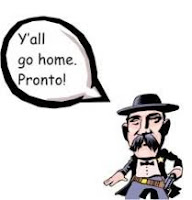How a character speaks can be just as important as what he or she says. It's important to craft dialogue that is consistent with the characters you've created, speaking in a character's voice when you are in that character's POV––an all-inclusive "voice" that takes in speech, thoughts, and descriptions presented by that character.
One way to give a character a distinct voice is through dialect or accented speech. Dialect is dialogue spoken either a foreign or regional accent.
A few years ago, my family and I (two adults, one adolescent) drove from S. FL to Buffalo, NY. We were packed to the hilt with Christmas gifts, suitcases filled with clothes for Upstate NY weather, two dogs, and coolers filled with food and drink. It was a crowded but great trip, and we stopped along the way going and returning.
A rest stop in Beckley, West Virginia, provided a free handout from
Register-Herald journalist, John Blankenship, titled "Rich Sayings Popular Among Our Ancestors Are Still In Use."As a writer, I couldn't pass that up. I still have it for the Eudora Welty-style fiction I'll write one day with characters drawn from West Virginia, and using lines like:
- a-mite = a bit of something
- askeered = frightened beyond words
- battree = needed to start a car
- schoolin, book read = an education
- daid = not among the living
- jeat = did you eat
- Dawg, I sed come heya = calling a dog
- Meemaw or Mamaw = grandmother
- floories = snow flurries
- spitten snow = a lot of snow falling
This valuable five-page handout also provided information about the culture and language of southern West Virginia. For example:
- the dialect of southern WVA is recognizable for its distinct flattened and merged vowel sounds
- the dialect results from a merging of Scottish, Irish, English (Elizabethan), and German languages
- the relative isolation of the mountains for roughly 300 years has ensured the quality of speech that is reminiscent of earlier times.
**********
Writing dialect is a skill to be practiced. It requires listening carefully for the spoken words––use, pronunciation, and sentence structure. It's helpful to pick one or two distinctive characteristics to use. If you don't know anyone with the accent you want to convey, or can't travel to that region of the country, consider renting movies or listening to language audio tapes.
Reading authors who've successfully created regional dialects helps in this process, and more if the author had a firm grasp on the regionalism you might to portray in your character(s). Zora Neale Hurston, Harper Lee, Toni Morrison, Kathryn Stockett, and Eudora Welty come to mind.
Distinguishing between characters is more than tag-lined dialogue. It also requires attention to mannerisms and the way people speak, their cadence, word choice, and favorite expressions, including foul language.
As authors, we need to sufficiently characterize the characters we've created, because readers don't want to figure out what's being said. Salt-and-pepper dialogues go a long way in doing this. For example: a character is from Scotland. The author might use a dialogue tag to point our his accent with a mere "(said) with his slight Scottish brogue." Using a handful of words is all it takes to inform readers about his or her accent. So does the occasional hint by the character's use of expressions
Consider using common idiomatic expressions like the French Zut alors!, Mais oui, Bien, or Voila in dialogues to refresh readers about the character's nationality. This is the most likely way a French person would speak anyway, and using words like these keeps both writer and reader from stressing out.
Characters who use English as a second language can be portrayed by dialogue with dropped and/or rearranged words, as in: Excuse. Please to tell how far airport is?" This works wonders when used sparingly.
**********
Below are a few resources listed that could enhance the use of accented dialogues.
Visit Visual Accent Dialect Archive (VADA) is a video library of English-language accents and dialects from around the globe that serves performers and linguists studying language sound pronunciation.
Books
 |
| Multiple Awards |
Songcatcher skillfully uses dialect/accent in this 2000 drama film directed by Maggie Greenwald. It is about a musicologist researching and collecting Appalachian folk music in the mountains of western North Carolina. It is loosely based on the work of
Olive Dame Campbell, founder of the John C. Campbell Folk School in Brasstown, North Carolina, and that of the English folk-song collector,
Cecil Sharp, portrayed at the end of the film as Professor Cyrus Whittle. A wonderful
sound track is also available.
 |
| Meg Ryan & Kevin Kline |
French Kiss star and consummate actor, Kevin Kline, does a convincing accent of a charming Frenchman in this 1995 American romantic comedy co-starring Meg Ryan. It's a fun movie for witnessing accent, hand gestures, and body movement in the French manner.
French Kiss was filmed on location in France, and many characters in the film are English-speaking French people.
I enjoy reading authors who know how to use accent and dialect well in stories. Although I haven't a character with dialect to date, I know what I need to learn to do it successfully and without frustrating myself or my readers. Hopefully, this has helped demystify the use of dialect and accent for your present or future characters.








